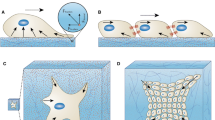Abstract
During early development migratory mesenchymal cells navigate to distant sites where they aggregate to form a variety of embryonic organ rudiments. We present here a new model for mesenchymal cell morphogenesis based on the mechanical interaction between motile cells and their extracellular environment. The model is based on two properties of motile cells: (a) they are capable of generating large traction forces which can deform the extracellular matrix through which they move, and (b) the deformations they produce in their environment affect the direction of their movements. We derive field equations which describe the motion of cells in an elastic extracellular matrix and show that these equations can generate a variety of spatial patterns, such as the formations of skin organ primordia, especially feather germs, cartilage condensation patterns which presage bone formation in limb development, and melanocyte density patterns which form animal coat patterns.
Similar content being viewed by others
References
Bronner, M., Cohen, A.: Migratory patterns of cloned neural crest melanocytes injected into host chicken embryos. Proc. Natl. Acad. Sci. USA 76, 1843–47 (1979).
Carter, S.: Principles of cell motility: the direction of cell movement and cancer invasion. Nature 208, 1183 (1965).
Carter, S.: Haptotaxis and the mechanism of cell motility Nature 213, 256–60 (1967).
Christiansen, R.: Mechanics of Composite Materials. New York: John Wiley 1979
Cohen, D. S., Murray, J. D.: A generalized diffusion model for growth and dispersal in a population. J. Math. Biol. 12, 237–49 (1981)
Dunn, G., Ebendahl, T.: Contact guidance on oriented collagen gels. Exp. Cell Res. 111, 475–79 (1978)
Elsdale, T., Bard, J.: Cellular interactions in mass cultures of human diploid fibroblasts. Nature, 236 152–55 (1972)
Folkman, J., Moscona, A.: Role of cell shape in growth control. Nature 273, 345–49 (1978)
Gustafson, T., Wolpert, L.: Cellular movement and contact in sea urchin morphogenesis. Biol. Rev. 42, 442–498 (1967)
Harris, A., Stopak, D., Wild, P.: Fibroblast traction as a mechanism for collagen morphogenesis. Nature 290, 249–51 (1981)
Landau, L., Lifshitz, E.: Theory of Elasticity, 2nd ed. New York: Pergamon Press 1970
Morse, P., Feshbach, H.: Methods of Theoretical Physics, Vol. 1, New York: McGraw-Hill 1953
Murray, J. D.: Nonlinear Differential Equation Models in Biology. Oxford: Clarendon Press 1977.
Murray, J. D., Oster, G. F., Harris, A. K.: A mechanical model for mesenchymal morphogenesis. J. Math. Biol. 17, 125–129 (1983)
Murray, J. D.: A pre-pattern formation mechanism for animal coat patterns. J. Theoret. Biol. 88, 161–199 (1981a)
Murray, J. D.: On pattern formation mechanisms for lepidopteran wing patterns and mammalian coat markings. Phil. Trans. Roy. Soc. London Ser. B 295 473–96 (1981b)
Odell, G., Oster, G., Burnside, B. Alberch, P. The mechanical basis of morphogenesis I: Epithelial folding and invagination. Devel. Biol. 85, 446–62 (1981)
Oster, G. F., Murray, J. D., Harris, A. K.: Mechanical aspects of mesenchymal morphogenesis. J. Embryol. exp. Morph. 78, 83–125 (1983)
Othmer, H.: Interactions of reaction and diffusion in open systems. Ph.D. Dissertation. Chem. Engr. Dept., Univ. of Minnesota 1969
Perelson, A., Murray, J. D., Oster, G. F.: Nonlinear behavior of the cell traction model for mesenchymal morphogenesis (in preparation) (1983)
Purcell, E.: Life at low Reynolds number. Amer. J. Phys. 45, 1–11 (1977)
Sengel, P.: Morphogenesis of Skin. Developmental and Cell Biology Series, vol. 3. Cambridge Univ. Press 1976
Turing, A. M.: The chemical basis of morphogenesis. Phil. Trans. R. Soc. Lond B237, 37–72 (1952)
Weiss, P.: Erzwingung elementarer strukturverschiedenheiten am in vitro wachsenden gewebe. Wilhelm Roux Arch. 116, 438–554 (1929)
Author information
Authors and Affiliations
Additional information
Support for this work was provided by NSF Grant # MCS-8110557 [GFO]
Rights and permissions
About this article
Cite this article
Murray, J.D., Oster, G.F. Cell traction models for generating pattern and form in morphogenesis. J. Math. Biology 19, 265–279 (1984). https://doi.org/10.1007/BF00277099
Received:
Revised:
Issue Date:
DOI: https://doi.org/10.1007/BF00277099




